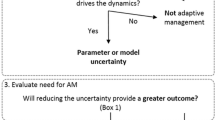Abstract
A framework for and a computational model of organizational behavior based on an artificial adaptive system (AAS) is presented. An AAS, a modeling approach based on genetic algorithms, enables the modeling of organizational learning and adaptability. This learning can be represented as decisions to allocate resources to the higher performing organizational agents (i.e., individuals, groups, departments, or processes, depending on the level of analysis) critical to the organization's survival in different environments. Adaptability results from the learning function enabling the organizations to change as the environment changes. An AAS models organizational behavior from a micro-unit perspective, where organizational behavior is a function of the aggregate actions and interactions of each of the individual agents of which the organization is composed. An AAS enables organizational decision making in a dynamic environment to be modeled as a satisficing process and not as a maximization process. To demonstrate the feasibility and usefulness of such an approach, a financial trading adaptive system (FTAS) organization is computationally modeled based on the AAS framework. An FTAS is an example of how the learning mechanism in an AAS can be used to allocate resources to critical individuals, processes, functions, or departments within an organization.
Similar content being viewed by others
References
Ariel, R.A. (1987), “A Monthly Effect in Stock Returns”, Journal of Financial Economics, 18(1), 1–14.
Booker, L.B., D.E. Goldberg and J.H. Holland (1989), “Classifier Systems and Genetic Algorithms”, Artificial Intelligence, 40(1–3), 235–282.
Carley, K. (1991). “Designing Organizational Structures to Cope with Communication Breakdowns: A Simulation Model”, Industrial Crisis Quarterly, 5(1), 19–57.
Carley, K.M. (1992), “Organizational Learning and Personnel Turnover”, Organization Science, 3(1), 20–46.
Chandler, A. (1962), Strategy and Structure: Chapters in the History of the Industrial Enterprise. Cambridge, MA: MIT Press.
Ching, C., C.W. Holsapple and A.B. Whinston (1991), “Reputation, Learning, and Coordination in Distributed Decision-Making Contexts”, Organization Science, 2(1), 1–23.
Crowston, K. (1994), “Eyolving Novel Organizational Forms”, in K. Carley and M. Prietula (Eds.) Computational Organization Theory. Hillsdale, NJ: Lawrence Erlbaum Associates.
Deng, P., C.W. Holsapple and A.B. Whinston (1990), “A Skill Refinement Learning Model for Rule-Based Expert Systems”, IEEE Expert, 5(1), 15–28.
DiMaggio, P.J. and W.W. Powell (1983), “The Iron Cage Revisited: Institutional Isomorphism and Collective Rationality in Organizational Fields”, American Sociology Review, 48(1), 147–160.
Engel, C. and J.D. Hamilton (1990), “Long Swings in the Dollar: Are They in the Data and Do Markets Know It?” American Economic Review, 80(4), 689–713.
Fama, E.F. (1970), “Efficient Capital Markets: A Review of Theory and Empirical Work”, Journal of Finance, 25(2), 1141–1148.
Froot, K.A., D.S. Scharfstein and J.C. Stein (1992), “Herd on the Street: Informational Inefficiencies in a Market with Short-Term Speculation”, Journal of Finance, 47(5), 1461–1484.
Glance, N.S. and B.A. Huberman, (1993), “The Outbreak of Cooperation”, Journal of Mathematical Sociology, 17(4), 281–302.
Goldberg, D.E. (1889), Genetic Algorithms in Search, Optimization, and Machine Learning. Reading, MA: Addison-Wesley.
Graham, B., D.L. Dodd and S. Cottle (1962), Security Analysis (4th edition). New York: McGraw-Hill.
Hannan, M.T. and J.H. Freeman (1977), “The Population Ecology of Organizations”, American Journal of Sociology, 82(5), 929–964.
Hansford, L.C., J.R. Grove and P.J. Sweeney (1992), “Using Simulation Technology in Organizational Development”, Journal of Systems Management, 43(2), 28–37.
Holland, J.H. (1986), “Escaping Brittleness: The Possibilities of General-Purpose Learning Algorithms Applied to Parallel Rule-Based Systems”, in R.S. Michalski, J.G. Carbonell and T.M. Mitchell (Eds.), Machine Learning: An Artificial Intelligence Approach, Palo Alto, CA: Morgan Kaufmann, Vol. II.
Holland, J.H. and J.H. Miller (1991), “Artificial Adaptive Agents in Economic Theory”, American Economic Review, 81(2), 365–370.
Holland, J.H. (1992), “Genetic Algorithms”, Scientific American, 267(1), 66–72.
Holsapple, C.W., K.Y. Tam and A.B. Whinston (1988), “Adapting Expert System Technology to Financial Management”, Financial Management, 17(3), 12–22.
Huber, G.P. (1984), “The Nature and Design of Post-Industrial Organizations”, Management Science, 30(8), 928–951.
Jacobs, B.I. and K.N. Levy (1988), “Calendar Anomalies: Abnormal Returns at Calendar Turning Points”, Financial Analysts Journal, 44(6), 28–39.
Jaffe, J. and R. Westerfield (1985), “The Week-end Effect in Common Stock Returns: The International Evidence”, Journal of Finance, 40(2), 433–454.
Jensen, M.C. and G.A. Benington (1970), “Random Walks and Technical Theories: Some Additional Evidence”, Journal of Finance, 25(2), 469–482.
Lant, T.K. and S.J. Mezias (1990), “Managing Discontinuous Change: A Simulation Study of Organizational Learning and Entrepreneurship”, Strategic Management Journal, 11(SP), 147–179.
Lawrence, P.R. and J.W. Lorsch (1967), Organization and Environment: Managing Differentiation and Integration. Cambridge, MA: Harvard Business School.
Mamis, J. and R. Mamis (1977), When to Sell: Inside Strategies for Stock-Market Profits. New York: Cornerstone.
Masuch, M. and P. LaPotin (1989), “Beyond Garbage Cans: An AI Model of Organizational Choice”, Administrative Science Quarterly, 34(1), 38–67.
Meyer, J.W. and B. Rowan (1977), “Institutional Organizations: Formal Structure as Myth and Ceremony”, American Journal of Sociology, 83(2), 340–363.
Morecraft, J.D.W. (1985), “Rationality in the Analysis of Behavioral Simulation Models”, Management Science, 31(7), 900–916.
Murphy, J.J. (1986), Technical Analysis of the Futures Markets. New York: Prentice Hall.
Pfeffer, J. and G.R. Salancik (1978), The External Control of Organizations. New York: Harper and Row.
Ridley, M. (1992), “Yes, it can be done”, The Economist, 329(7832SP), 21–23.
Simon, H.A. (1981), The Sciences of the Artificial (2nd edition). Cambridge, MA: MIT Press.
Singh, J.V., R.J. House and D.K. Tucker (1986), “Organizational Change and Organizational Mortality”, Administrative Science Quarterly, 31(4), 587–611.
Sterman, J.D. (1987), “Testing Behavioral Simulation Models by Direct Experiment”, Management Science, 33(12), 1572–1592.
Van de Ven, A.H. and R. Drazin (1985), “The Concept of Fit in Contingency Theory”, in B.M. Staw and L.L. Cummings (Eds.) Research in Organizational Behavior, p. 7, Greenwich, CT: JAI.
Zweig, M. (1986), Winning on Wall Street, New York: Warner.
Author information
Authors and Affiliations
Rights and permissions
About this article
Cite this article
Paul, D.L., Butler, J.C., Pearlson, K.E. et al. Computationally modeling organizational learning and adaptability as resource allocation: An artificial adaptive systems approach. Comput Math Organiz Theor 2, 301–324 (1996). https://doi.org/10.1007/BF00132314
Issue Date:
DOI: https://doi.org/10.1007/BF00132314




